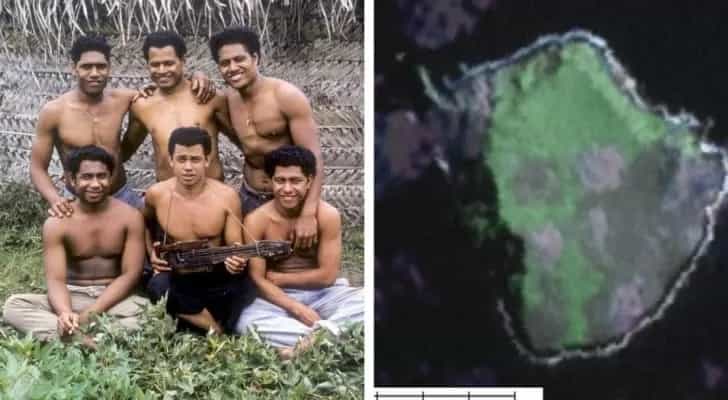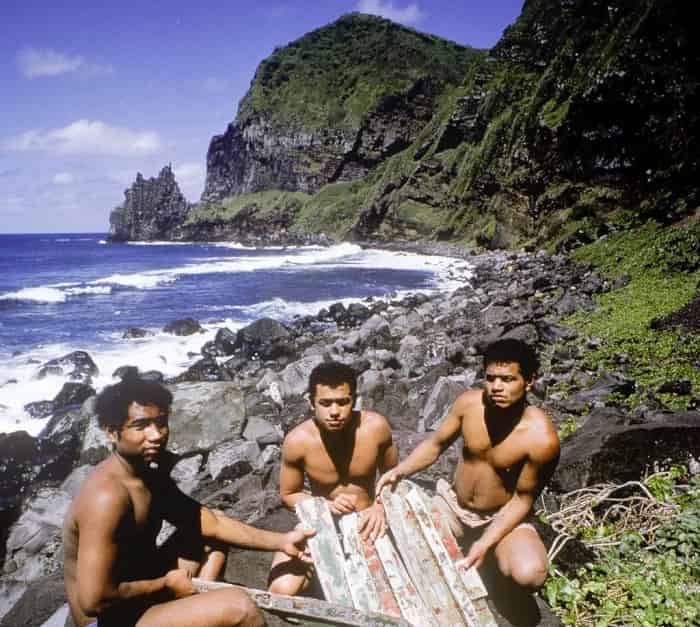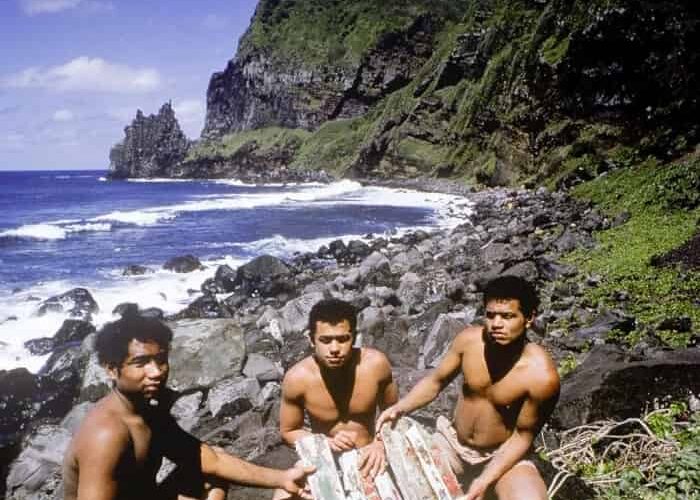Six Tongan Teenagers’ Incredible Survival on Ata Island: A True South Pacific Adventure

In 1965, an unbelievable true story unfolded in the vast South Pacific Ocean. Six brave teenagers from Tonga became stranded on a small, deserted island called Ata.
Their adventure lasted 15 long months, filled with challenges, hope, and the power of friendship. Today, we share this amazing survival story in easy English. In this article, you will read about how these Tongan castaways managed to survive, the hardships they faced, and how they were finally rescued. This true island survival story is one of courage, resilience, and human spirit.
The Beginning: A Bold Decision That Changed Lives
In June 1965, six teenagers from Tonga’s St. Andrew’s Anglican boarding school made a life-changing decision. They stole a boat in an attempt to leave their island home and find a better life in New Zealand. The boys were filled with dreams and excitement for what the future might hold. Their names were:
- Luke Veikoso
- Stephen Tevita Fatai Latu
- Sione Fataua
- David Tevita Siolaʻa
- Kolo Fekitoa
- Mano Sione Filipe Totau
The idea of leaving everything behind was both thrilling and dangerous. They had little experience with the open sea, but the lure of a new life pushed them to take a risk. However, their plan soon went terribly wrong.
The Storm and Shipwreck: An Unexpected Twist
On the very first night at sea, a fierce storm hit their small boat. The raging winds and towering waves changed everything. The storm wrecked their plans and left them drifting for eight long days in the vast ocean. Without food, water, or shelter, the boys faced extreme hunger and thirst. Their small boat became a lifeboat in a sea of uncertainty.
After these difficult days at sea, the boys finally reached a tiny, uninhabited island in the South Pacific. This island was known as Ata. Little did they know, their survival journey was just beginning.
Life on Ata Island: A Struggle for Survival
When the teenagers landed on Ata Island, they were weak and injured. Their bodies bore the marks of the long journey, with cuts and bruises from the rough landing. Having been without food for eight days, the boys were starving and desperate for water.
Finding Food and Water
The island did not offer easy food sources. The boys had to rely on nature to sustain them. Initially, they caught sea birds to have something to eat. In a desperate bid for hydration, they even drank the blood of these birds. This unusual method gave them the moisture they needed, but it was not enough to keep them strong for long.
After a few months on the island, the teenagers found an old set of knives hidden on Ata. With these knives, they discovered a new way to survive: they could now open coconuts. The sweet coconut milk provided a much-needed source of energy and hydration. Drinking coconut water became a turning point in their struggle for survival.
Creating Shelter and Tools
The natural environment of Ata Island offered resources that the boys could use to build a home. They gathered tree branches and palm fronds to construct a shelter. This simple house gave them a safe place to sleep and protected them from the harsh weather. Using the knowledge passed down from their fathers and community, the boys learned to identify which trees stored water in their trunks. Tapping into these trees provided them with a steady water source.
Building shelter and finding water were essential for the boys’ survival. Every day, they learned new skills to adapt to their surroundings. They spent hours exploring the island, learning its secrets, and understanding how to live in harmony with nature.

Hardships and Heartbreak on the Island
Life on Ata Island was far from easy. The boys faced constant challenges that tested their physical and mental strength. Despite these hardships, they remained determined to survive together.
The Painful Accident
One day, while hunting for sea birds, one of the boys had a terrible accident. He was climbing a steep cliff when he slipped and fell 40 feet. The fall resulted in a broken leg—a serious injury on a deserted island. The boy’s fall brought worry and fear among his friends. However, the strength of their friendship and teamwork shone through. With the help of his fellow castaways, the injured boy managed to heal. They carefully cared for him, showing that even in dire circumstances, compassion and unity could help overcome physical pain.
Attempts to Leave the Island
The boys did not lose hope during their time on Ata. After six months, when they had built a stronger bond with the island and learned how to survive, they decided it was time to try to leave. They built a small raft with the hope of escaping the island and finding help. Unfortunately, their plan did not work as they had hoped. Their makeshift raft was destroyed when it hit rocks in the open sea. The failure of this escape attempt brought despair to the group.
To add to their sadness, the boys later learned that their families had already held funerals for them on their Tongan islands, believing they had perished at sea. The thought of their families mourning them added a heavy emotional burden to the already difficult situation.
The Long Wait: Standing Guard for 15 Months
For over a year, the six teenagers spent their days and nights on Ata Island, always on the lookout for any sign of rescue. Every day, they took turns standing on high cliffs, scanning the horizon for a passing boat or plane. Their hope never faded, even when the days were long and filled with uncertainty.
Imagine standing for hours, day after day, waiting for a small sign that could change your life forever. This constant vigilance was both physically exhausting and mentally taxing. Yet, the boys continued to hold onto hope. They believed that one day, someone would come to save them.
The Glimmer of Hope: The Rescue
After 15 months of living on Ata Island, their prayers were finally answered. One day, the appointed watchman on the island shouted, “Boat coming!” A small traveler named Peter Warner, from Sydney, Australia, was piloting a boat near the island. His crew heard the desperate shouts from the castaways standing on the cliff and immediately came to their rescue.
The boys wasted no time. They swam through the ocean to reach the boat, clinging to hope and relief. Finally, after months of isolation, they were saved. Their long ordeal had come to an end, and the news of their rescue spread quickly.
Life After Rescue: Return to Tonga
The rescue of the six teenagers was a moment of overwhelming joy and relief. They were taken back to Tonga, where they were greeted by tearful family members who had feared the worst. However, the boys faced new challenges upon returning home.
Shortly after their arrival, the castaways were arrested. The authorities charged them with stealing the boat. Despite this, their families and the public were filled with compassion and understanding. In a remarkable turn of events, Peter Warner, the rescuer, paid for the cost and damages of the stolen boat. The payment, which was $203 USD at that time, was enough to have the charges dropped against the boys.
For three days and nights, the islanders celebrated the return of the castaways and the bravery of their rescuer. The story of these Tongan teenagers became a symbol of hope, resilience, and the power of community.
The Documentary: Bringing the Story to the World
The incredible survival story of the Tongan teenagers captured the attention of the media. Peter Warner arranged for Channel 7 news in Sydney, Australia, to film their story. A documentary was made that recounted every detail of their time on Ata Island, from the dangerous journey at sea to the day of their rescue.
This 1966 documentary is a rare piece of history. It shows the boys’ experiences on the island and even includes a reenactment of their survival adventure. Today, only one copy of this documentary survives, and it is available on YouTube. Viewers around the world can witness the raw reality of this survival story, gaining insight into the incredible determination and resourcefulness of these young castaways.
A Real-Life Tale Resembling “Lord of the Flies”
Many people compare the survival story of these Tongan teenagers to the famous novel “Lord of the Flies” by William Golding. In Golding’s book, a group of boys is stranded on an island, and their situation quickly descends into chaos and conflict. However, the true story of the Tongan castaways is very different. Instead of turning on each other, the boys supported one another throughout their ordeal. Their unity and cooperation are a testament to the strength of their bond and the lessons taught by their families and culture.
This contrast between fiction and reality makes the story even more remarkable. It shows that, even in the most challenging circumstances, young people can work together to overcome adversity. Their example serves as an inspiration for people around the world.
Modern-Day Exploration: Revisiting Ata Island
The legacy of the Tongan castaways continues to inspire exploration and storytelling. In 2015, a Spanish explorer named Alvaro Cerezo visited Ata Island. He spent 10 days on the island with one of the castaways, Kolo Fekitoa, who was in his mid-60s by that time. During this visit, Cerezo and Kolo lived much like the boys did in 1965. They survived by eating coconuts, fish, and seabirds, reconnecting with the raw nature of island life.
Alvaro Cerezo’s journey was not just an adventure. It was a chance to revisit history, honor the past, and show how the lessons of survival remain relevant. In the summer of 2020, Cerezo released a documentary about his experience with Kolo Fekitoa. He also published a book that detailed the 15-month ordeal of the castaways on Ata Island. This modern-day exploration has helped bring new attention to the extraordinary events of 1965-1966 and reminded us of the timeless human spirit of survival.
The Impact on History and Culture
The survival story of these six Tongan teenagers is not only a tale of adventure and endurance—it has also left a lasting impact on Tongan history and culture. Their ordeal is remembered as a powerful example of how young people can overcome impossible odds through courage and unity. The story is celebrated in Tonga and has inspired books, documentaries, and even films that retell their journey.
Historians and writers have been drawn to the tale, finding in it themes of resilience, hope, and the deep connection between people and nature. In 2020, historian Rugter Bregman published a book titled “The Humankind: A Hopeful History.” This book explores the civilized experiences of the castaways and reflects on the enduring hope that drives humanity forward, even in the face of overwhelming challenges.
The Enduring Mystery and Adventure of Ata Island
Ata Island itself remains a place of mystery and intrigue in the South Pacific. Although it is small and isolated, the island has become famous because of the survival story that took place there. Visitors and explorers are often drawn to Ata Island by the legend of the Tongan castaways. The island serves as a living reminder of the power of nature and the resilience of those who call it home, even if only for a short time.
In recent years, Ata Island has been featured in various historical accounts and documentaries, attracting interest from people all over the world. The island’s rugged beauty and the story of survival that unfolded on its shores offer a unique glimpse into a world where nature and human determination intersect.
Frequently Asked Questions (FAQs)
What is the story of the Tongan castaways on Ata Island?
In 1965, six teenagers from Tonga stole a boat to seek a better life in New Zealand. Their journey took a dramatic turn when a fierce storm left them stranded on the deserted Ata Island in the South Pacific for 15 months. During that time, they survived by catching sea birds, drinking coconut water, and building shelter from natural resources. Their incredible tale is one of hope, courage, and unity.
How did the boys manage to survive on Ata Island?
The boys relied on their resourcefulness and traditional Tongan survival skills. They found food by catching sea birds and later used old knives to open coconuts for hydration and energy. They built a shelter from tree branches and palm fronds, discovered ways to tap water from trees, and supported each other through injuries and setbacks. Their strong teamwork was crucial to their survival.
Who rescued the stranded teenagers?
After 15 months on the island, the castaways were rescued by Peter Warner, a traveler from Sydney, Australia. Warner and his crew heard the boys’ shouts from a clifftop and immediately came to help, finally ending their long ordeal.
What challenges did the boys face on the island?
The castaways encountered many hardships including severe storms at sea, a dangerous landing that left them injured and starving, and a failed attempt to escape using a makeshift raft. They also dealt with the emotional burden of learning that their families had already held funerals for them back in Tonga.
How did the story of these teenagers compare to the novel “Lord of the Flies”?
While William Golding’s “Lord of the Flies” depicts boys turning against each other in a struggle for power, the true story of the Tongan castaways shows a remarkable display of unity and cooperation. Instead of descending into chaos, the boys worked together to overcome their hardships and support one another.
Are there any documentaries or books about their survival?
Yes! A 1966 documentary was made by Channel 7 in Sydney that recounts the boys’ experience on Ata Island. Although only one copy of the original documentary survives today and is available on YouTube, more recent works include a documentary and book released by Spanish explorer Alvaro Cerezo in 2020, along with a book by historian Rugter Bregman.
What lessons can we learn from this survival story?
This incredible journey teaches us many lessons: the importance of courage in the face of adversity, the power of unity and teamwork, adaptability and resourcefulness, and the enduring hope that can help overcome even the most difficult challenges. It also highlights the value of cultural knowledge and community.
Why is Ata Island significant today?
Ata Island is renowned for being the site of this extraordinary survival story. Its rugged beauty and mysterious nature continue to attract explorers and historians, serving as a lasting reminder of the strength and resilience demonstrated by the Tongan castaways.

